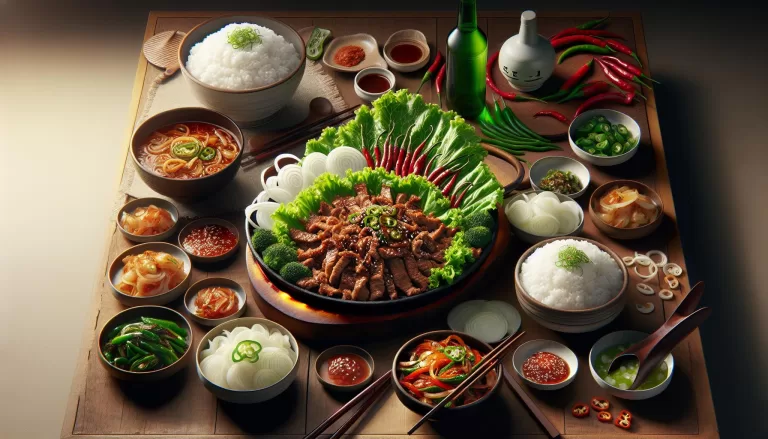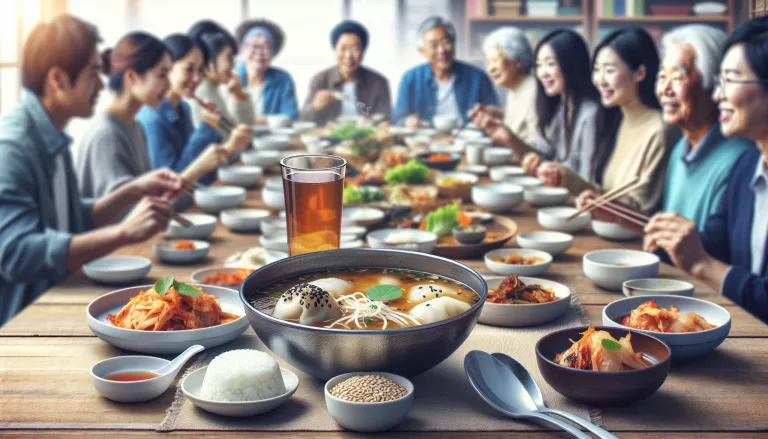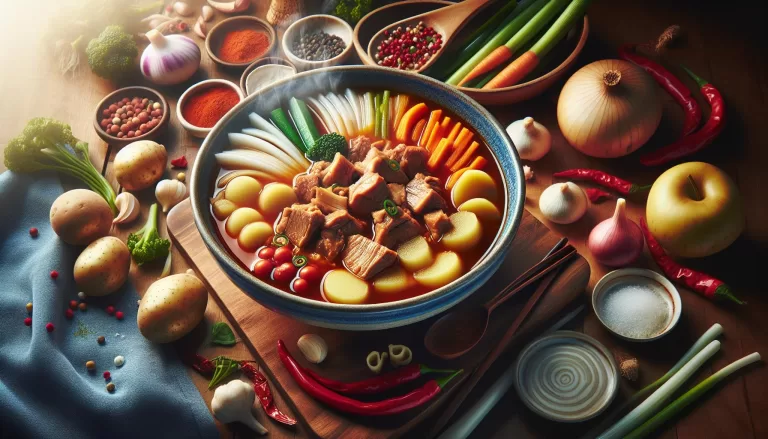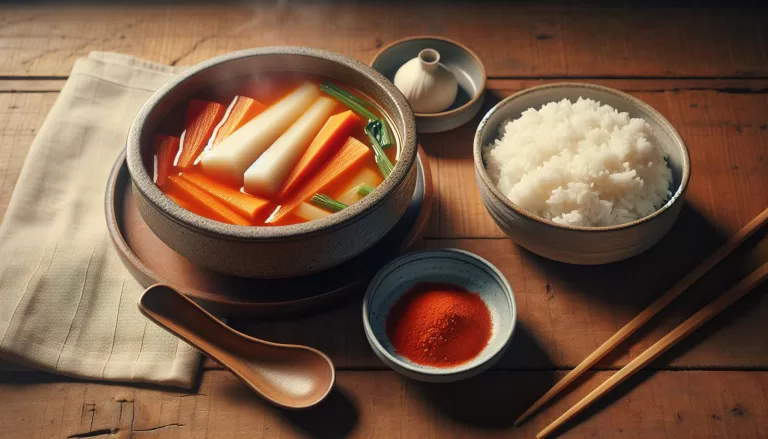Easy and Customizable Homemade Jjam Bbong Korean Chinese Spicy Noodle Recipe

Overview of Jjam Bbong
Jjam Bbong is a staple in Korean-Chinese cuisine. Spicy, hearty, and packed with a myriad of flavors, it’s a dish that leaves a lasting impression. You will find every spoonful teeming with savory spices, a variety of seafood, and firm, slippery noodles – a truly satisfying combo if there ever was one.
What’s more, creating your version of jjam bbong doesn’t have to be daunting. With the right ingredients and technique, you’ll be dishing out this sumptuous meal at your dining table. Let’s delve into the world of flavor that is jjam bbong.
Key Ingredients and Instructions
Jjam Bbong’s primary ingredients include seafood, particularly mussels and prawns. Additionally, vegetables such as onions, cabbage, and spinach add to its refreshing taste. It’s the mix of these ingredients that gives jjam bbong its unique flavor profile.
Here’s a quick rundown of the process:
- Start by sauteing the vegetables with oil in a large pot over medium heat.
- Add the mussels and prawns to the pot and continue stirring.
- Pour in water, soy sauce and bring to a boil.
- Drop in your noodles and let them cook until they soak up all the flavors.
Alternative Ingredient Tips
If you’re unable to source any ingredients, know that there’s room for flexibility. For instance, if mussels or prawns aren’t accessible, feel free to substitute with other types of seafood such as squid or pieces of fish. Such adjustments won’t affect the overall taste and character of the dish.
Nutritional Value
The beauty of homemade jjam bbong is not just in its taste but also in its nourishing aspect. It’s packed with proteins from the seafood, essential vitamins from the vegetables, and filling carbs from the noodles. Below is the average nutritional value per serving:
| Nutrient | Value |
|---|---|
| Calories | 350 |
| Carbs | 45g |
| Proteins | 25g |
| Fat | 12g |
| Vitamins | A, B6, C, K |
Ingredients for Homemade Jjam Bbong

When you’re ready to bring the heat of Korean-Chinese spices to your kitchen, this variant of Jjam Bbong won’t disappoint. First off, you need high-quality, fresh ingredients. A flavorful Jjam Bbong is built on nutrient-packed components. Let’s explore what you’ll need.
For starters, seafood and vegetables play a key role in defining the bold and spicy profile of this dish. You’ll need handfuls of prawns and mussels, commonly used in traditional recipes. If you’re feeling adventurous, you can experiment with alternatives like scallops or squid. For the vegetable base, gather onions, carrots, and cabbages.
This dish wouldn’t be complete without its signature wide, chewy noodles – the jajangmyeon noodles. For gluten-free options, you can substitute with rice noodles or buckwheat noodles. The noodles are the canvas to your spicy, seafood-heavy masterpiece.
Let’s add flavor depth with pouches of Korean black bean paste and hot pepper paste. These are readily available in Asian grocery stores or even online. For a unique twist, consider adding a hint of ochujang (Korean chili paste) or miso paste.
A few more supporting ingredients to complete your list – a head of garlic, ginger, vegetable oil, salt, and sugar. A tip for the daring: spice it up with slivers of fresh jalapeño.
Here’s a quick list of your ingredients in a handy table for easy reference:
| Ingredients | Quantity |
|---|---|
| Seafood (prawns and mussels) | 2 cups |
| Vegetables (onions, carrots, cabbages) | 2 cups |
| Jajangmyeon noodles | 1 packet |
| Korean black bean paste | 2 pouches |
| Hot pepper paste | 1 pouch |
| Garlic | 1 head |
| Ginger | 1 piece |
| Vegetable oil, salt, sugar | As per taste |
Don’t forget: creativity in the kitchen allows room for improvisation. There’s no single “right” way to whip up a wonderful Jjam Bbong; personal taste preferences and dietary needs can guide your choices. Get, set, and start assembling your ingredients for a mouth-watering, home kitchen rendition of this favorite Korean-Chinese delight.
Step-by-Step Cooking Instructions

Ready to take your cooking skills to the next level? We’ve got your back! Roll up those sleeves and let’s get started with our homemade Jjam Bbong recipe.
- Fire up the stove! Get your big pot or wok warming up on a high heat. Add two tablespoons of vegetable oil and let it get sizzling hot.
- Now it’s time to infuse that oil. Grate one thumb-sized piece of fresh ginger and mince two cloves of garlic. Sauteing these two will release their aromatic flavors into the oil. Give it about 30 seconds but be careful not to burn them.
- Carefully add your sliced veggies to the pot. One large onion, two medium-sized carrots, and a quarter of a cabbage, all thinly sliced, work wonders. Give it a good stir till they soften up.
- Make some room in the middle of your pot for the superstar of our dish, the Korean black bean paste. Add about 3 tablespoons and let it cook for a minute. The heated paste gives off the unique flavors that make Jjam Bbong so special.
- Time to spice things up! Add one tablespoon hot pepper paste, if you’re game for some heat. Remember, you’re in charge here, so adjust the spice to suit your palate.
- Pour in your eight cups of vegetable broth and bring it all to a bubbling boil. This forms the flavorful base for our noodles.
- Drop in around 400 grams of Jajangmyeon noodles, stirring occasionally to avoid clumping.
- Lastly, add your handpicked seafood. The classic mix includes prawns and mussels, but feel free to experiment.
Tips for Perfecting Your Jjam Bbong

Getting jjam bbong just right can feel like a challenge even for seasoned home chefs. However, there are a few tips and tricks that you can use to elevate your craft.
Focus on Freshness. As with any dish, this meal begins with fresh ingredients. When you’re scouring the market for your produce and seafood, make sure everything’s at peak freshness. If the prawns are plump and the mussels glossy, you’re on the right track. Ripe, bright vegetables also make a world of difference.
Master the Balance. Jjam bbong is all about the thrilling interplay of flavors. The broth should be both piquant and savory, wrestling with the noodles’ firm chewiness. Sauté your veggies until they’re tender but still have a crunch. Allow the garlic and ginger to infuse the oil for just long enough that it doesn’t become overly bitter. It’s a game of balance!
Customize Your Spice Level. Remember, this recipe comes with flexibility. Some like it scorching while others prefer a modest kick of spice. Adjust the amount of hot pepper paste to your liking. After all, it’s your kitchen!
Here’s a tip you don’t usually get: Use a Splash of Fish Sauce. For an extra depth of flavor, add a splash of fish sauce. It provides a distinct umami kick that’ll make your soup unforgettable. If you don’t have fish sauce on hand, oyster sauce can work as a substitute.
Keep in mind the Nutritional Value. If you’re keeping tabs on your diet, this recipe offers a healthy dose of protein from the seafood, carbohydrates from the noodles, and vitamins from the vegetables. It strikes a balance in your diet too.
Remember, short, deliberate sentences, fresh ingredients, the balance of flavors, the right spice level, and considerate customization can take your jjam bbong to new heights.
Adding Your Own Twist to the Recipe

Pushing the boundaries of classic recipes, like Jjam Bbong, means tailoring them to your unique taste. You’re not just cooking to please the crowd – you’re cooking to enjoy the process, achieve the flavors you crave, and create something entirely yours.
Start with the amount of heat. Remember that the spice level of Jjam Bbong is not fixed. Some like it hot, while others prefer a milder heat. Start with less chili paste – you can always add more later.
Consider adding new ingredients. For example, have you ever thought to finish your bowl of Jjam Bbong with a splash of sesame oil? Its nutty aroma deepens the dish’s flavor profile. Or, maybe you’ve wanted to try adding some unconventional veggies. Spinach or bok choy could shake things up.
Don’t shy from substituting ingredients based on what you have on hand, or personal preferences. Chicken or tofu can replace the traditional pork. Vegetable broth can stand in for the seafood-based broth. It’s your dish, after all.
Remember the nutritional content of your dish. Homemade Jjam Bbong is an opportunity to pack in the protein, fiber and other essential nutrients. Use fresh, locally sourced ingredients where you can. Here is a table for the nutritional value of your dish based on the ingredients used.
| Nutrient | Amount |
|---|---|
| Calories | ————- |
| Carbs | ————- |
| Protein | ————- |
| Fat | ————- |
| Vitamins | ————- |
Get creative – that’s how you make a memorable dish. One that’s not just mouth-watering, but deeply personal too. Oh, and don’t forget to enjoy the cooking journey itself. After all, isn’t that what home cooking’s all about?
Conclusion
So, you’ve journeyed through the ins and outs of crafting your own Jjam Bbong, a Korean-Chinese spicy noodle dish that’s both flavorful and adaptable. Remember, it’s your kitchen and your rules. Don’t be afraid to tweak the heat to your liking or bring in new ingredients. Perhaps a dash of sesame oil or a fresh vegetable medley will make it uniquely yours. And while you’re at it, keep an eye on the nutritional value. It’s not just about taste, but also about fueling your body right. Ultimately, cooking should be a joy, a creative outlet where you can make something truly personal. So, go ahead, roll up your sleeves and whip up your own version of Jjam Bbong. Enjoy every step of the process, and most importantly, savor every bite.





